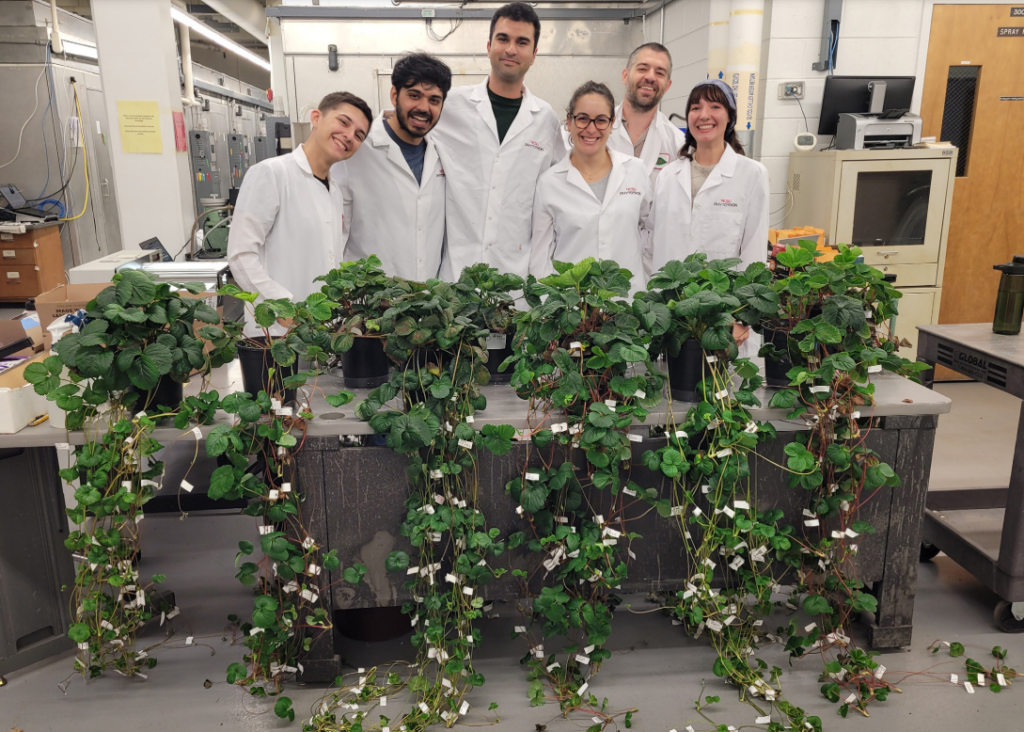Article and photography by Sam Humphrey

At North Carolina State University, you will find a building called Phytotron, full of large, controlled environment plant growth chambers. Several of these chambers are being used for Samson Humphrey’s master’s research project on strawberry propagation. Sam works alongside Dr. Ricardo Hernández and PhD student Moein Moosavi on the PIP-CAP physiology team to test different environmental conditions on strawberry plants (such as different light intensity, light quality, photoperiod, and CO2 treatment conditions) to determine which conditions grow as many daughter plants as possible. The goal of this work is to use these environmental cues to manipulate the plants to grow as many high-quality daughter plants as possible, using minimal inputs.
In Sam’s study, Sam grew strawberry plants in three chambers, each chamber with a different CO2 concentration: either 500, 850, or 1200 µmol mol-1. Each chamber was split down the middle to create a low light intensity (250 µmol m-2 s-1, (DLI: 14.4 mol m-2 d-1 or a high light intensity (500 µmol m-2 s-1, DLI: 28.8 mol m-2 d-1) subtreatment. For the first repetition of this experiment, Sam used Fronteras and Monterey mother plants.Throughout this experiment, Sam has tracked the temperature, relative humidity, CO2 concentration, and volumetric water content of the substrate.
Walking into one of these strawberry chambers feels almost like a strawberry jungle: A canopy of mother plants produces a cascade of hundreds of daughters, with stolons intertwined as they loosely dangle. Every day, Sam reaches above the plants and crawls below the benches to track daughter development. With the daughter naming system, he logs each new daughter that develops, and digitally maps its position within the stolon network. This daily development data will allow him to run analyses on the rate of daughter development and stolon development. He can statistically analyze the daughters separately, based on their branching position, date of initiation, distance from the mother plant, and more. He is hoping this data will provide insight into the development rate and branching pattern of these plants, to inform management decisions.
By the time of this writing, Sam’s mother plants have grown between 30 and 120 daughter plants per mother, with an average of around 80 daughter plants per mother: a huge increase over what would typically be seen in the field (about 25). The exact number of daughter plants varies depending on treatment, and although the project is still ongoing, Sam believes that the plants with the highest CO2 concentration and the highest light intensity produce the most daughters per mother. In the first repetition of this experiment, for Monterey the 850 µmol mol-1 and 1200 µmol mol-1 CO2 concentrations produced 13.2% and 8.5% more daughter plants per mother plant than the 500 treatment. For Fronteras, the 850 µmol mol-1 and 1200 µmol mol-1 CO2 concentrations produced 16.9% and 12% more daughter plants per mother plant than the 500 treatment. Additionally, the impact of increasing light intensity (from 250 µmol m-2 s-1 to 500 µmol m-2 s-1) resulted in a 28% (Monterey) and 69% (Fronteras) increase in daughter plants per mother plant.
It seems that CO2 enrichment may be a way to improve daughter plant number or growth rate of mother plants, so please keep an eye on the PIP-CAP news for the final analysis and potential recommendations. Greater CO2 and greater light intensity may be just one more tool we can utilize to make strawberry propagation more sustainable and more profitable in greenhouses and controlled environments.